without stirrups. Calisthenic exercises. Stopping and walking. Individual turn. Successive semiturn. Successive turn. Trotting, Calisthenics, etc., as above, while trotting. Walking. Individual halfturn. Individual turn, stopping, and starting again to a trot. Galloping. Calisthenic exercises, etc., as in walking and trotting. Stopping and starting to the gallop. This whole programme is to be gone through, first with stirrups, and then a second time without.
The time has not yet come for learning to manage the horse. This will come later. At the end of the second year, the young pupil ought to be able to perform all these movements easily, without stirrups. Circular movements have been included in the programme, since the pupil should be made accustomed to all directions and to producing all kinds of movements.
Let the pupil also bear in mind that just as to become a good sailor one must not be afraid of seasickness, so to become a good rider one must not be afraid of the rough movements of the horse. Once accustomed to these, one learns in due time to counteract them. But if one tries from the start to repress these sudden jerks, he never becomes used to them, and his contractive efforts will, sooner or later, be turned into stiffness.
Now this condition of stiffness is precisely what the learner ought to avoid from the very outset. But for the beginner the greatest difficulty of all is
